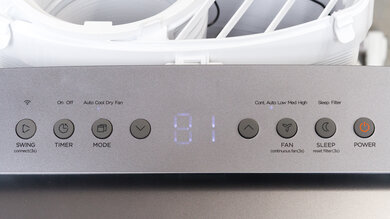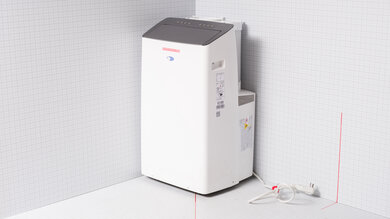- Table of Contents
- Intro
- Best Air Conditioner
- Best Mid-Range
- Best Budget
- Notable Mentions
- All Reviews
- Comments

Portable air conditioners fill a much-needed role within the mobile A/C market since not everyone has the space for a window-mounted model, which takes more effort to set up and take down at the end of every warm season. The best portable air conditioners feature design aspects like separate intake and exhaust hoses to more effectively isolate cooled indoor air from warm outdoor air and inverter compressors that consume less energy (and make less noise) than non-inverter units.
Then again, as anyone who's ever had to wrangle a set of hoses and dealt with ceiling fan-level cooling performance would know, many portable air conditioners are far from perfect. They have some inherent disadvantages versus a window unit: even the best models operate less efficiently than a window unit with comparable capacity and features. As it turns out, placing a heat-generating component like a compressor outside of the room you're trying to cool is a pretty major boon regarding efficiency. If you're interested, you can also see our recommendations for the best window A/Cs.
Of course, as with any product we test, there's never going to be a single one-size-fits-all solution. We've tested 20 air conditioners to date, and below are our recommendations for what we think are the best portable units on the market within their distinct price brackets.
-
Best Portable Air Conditioner
Large Room8.0Bedroom/Small Room7.6Performance Usages: Combined Efficiency7.7Oversizing Tolerance8.1Noise8.4TypeDual-Hose Portable A/CAdvertised Capacity (DOE)12,000 BTU/hrTested Capacity9,256 BTU/hr (2,714 W)Compressor TechnologyInverterThe best portable air conditioner that we've tested is the Whynter NEX ARC-1230WN. This high-end portable unit packs in all the bells and whistles one could want in an A/C unit. There's integrated Wi-Fi connectivity, allowing you to operate the unit or monitor the ambient temperature at home while you're at work via the NetHome Plus companion app, which also offers Google Home and Amazon Alexa integration. Beyond that, it has a dedicated dehumidification-only setting and a space-saving two-in-one hose design that makes it a little more compact than some other dual-hose models (though there's still no getting around this being a genuinely bulky appliance).
Despite its substantial cooling capacity, enough to cool even big open-concept living spaces all by itself, it doesn't suffer from the same oversizing issue that plagues non-inverter models: its inverter compressor can run at a lower speed instead of cycling on and off when maintaining your desired setpoint. This minimizes fluctuations in temperature and, crucially for a unit with this level of cooling capacity, prevents it from cooling a room more quickly than it can dehumidify. The result is that your room should feel comfortably cool and dry instead of damp and chilly.
-
Best Mid-Range Portable Air Conditioner
Large Room7.7Bedroom/Small Room7.8Performance Usages: Combined Efficiency7.3Oversizing Tolerance8.4Noise8.6TypeDual-Hose Portable A/CAdvertised Capacity (DOE)10,000 BTU/hrTested Capacity7,533 BTU/hr (2,209 W)Compressor TechnologyInverterIf you can't justify a portable A/C unit with the kind of capacity offered by the Whynter NEX ARC-1230WN, the Midea Duo MAP12S1TBL is a slightly more affordable option that delivers a very similar breadth of features. That isn't overly surprising, as it's nearly the same unit as the Whynter: it uses the same digital interface, and Whynter's NetHome Plus app is effectively a reskinned variation of the Midea Air smartphone app. Its space-saving two-in-one hose design is also very similar.
The main differences between the units lie in their inverter compressors, with this Midea model having slightly lower capacity, to the tune of roughly 20%. As a result, it'll take a little longer to cool a comparably sized space, though this model is still a strong performer in this regard and won't have any trouble in most bedrooms or even larger living spaces. Its inverter technology also allows for relatively efficient operation and minimal swings in temperature or humidity while the unit maintains the setpoint, and it's quiet enough to leave running while you're listening to music or watching TV.
-
Best Budget Portable Air Conditioner
Large Room5.1Bedroom/Small Room6.2Performance Usages: Combined Efficiency4.9Oversizing Tolerance7.5Noise4.4TypeSingle-Hose Portable A/CAdvertised Capacity (DOE)4,000 BTU/hrTested Capacity3,335 BTU/hr (978 W)Compressor TechnologyNon-InverterLastly, if you're on a tight budget and only need a basic A/C, the SereneLife SLPAC8 could be for you. Unlike the Midea Duo MAP12S1TBL and Whynter NEX ARC-1230WN, this portable unit is designed exclusively for small spaces and has a single-hose design. While this cuts down on complexity and makes for a more compact machine, there's no getting around the fact that this design comes with inherent sacrifices in terms of efficiency and general cooling performance. Single-hose models like this take in indoor air from the room they're cooling, generating negative air pressure and drawing in warm air from the outdoors or even simply from uncooled areas inside your home. This influx of warm air forces the machine to work even harder. Despite this model's low capacity, it consumes more power than the far more powerful Whynter or Midea.
However, that poor efficiency isn't solely down to the SereneLife model's single-hose design. Its low capacity means the compressor is forced to run constantly, even in modestly-sized spaces, instead of cycling on and off as a non-inverter compressor should. Once again, this makes for highly inefficient operation while the unit maintains your desired setpoint, and it could accelerate wear and tear over time. However, there's a benefit to this constant running: it helps minimize swings in humidity and temperature since at no point does the machine cycle its compressor. In terms of quality-of-life features, this model is also well-rounded for something this affordable: it has a separate dehumidification setting, an easy-to-set digital thermostat, and a remote control to operate the unit without getting off the couch or rolling out of bed.
Notable Mentions
- Hisense HAP0824TWD:
The Hisense HAP0824TWD is a portable A/C with a dual-hose design and an inverter compressor. That makes it relatively power-efficient in both cooling and maintaining a desired setpoint, but the Midea Duo MAP12S1TBL simply outperforms it in most key ways. The Midea offers greater cooling capacity, consumes even less power, and makes less noise while running.
See our review - LG DUAL Inverter LP1419IVSM:
The LG DUAL Inverter LP1419IVSM is a high-end portable A/C designed for medium to large spaces. It features a somewhat unique selling point: a dual-inverter compressor. Unfortunately, this unit is hamstrung by its single-hose design, which severely compromises its efficiency compared to dual-hose models like the Whynter NEX ARC-1230WN.
See our review
All Reviews
Our recommendations above are some of the best portable A/Cs for most people. We factor in the price, feedback from our visitors, and availability.
That said, there's no single best option that'll suit everybody; your needs will depend on your budget, the size of the space you're trying to cool, your tolerance for operating noise, and whether you like having a device with convenience features like Wi-Fi connectivity. If you'd like to choose for yourself, here's the list of all our portable A/C reviews.











